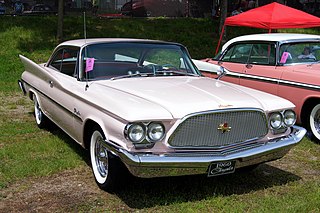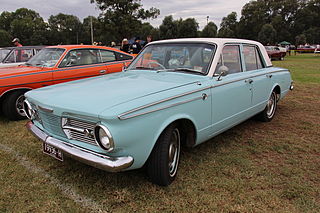
The Chrysler Royal was a full-size car produced by the Chrysler Corporation in the United States. It was first released in 1933 and continued being built until 1934. Then, the model ended production and did not return until 1937 - continuing until 1950.

The Dodge Diplomat is an American mid-size car that was produced by Dodge from 1977 to 1989. At launch, it shared a common design with the Chrysler LeBaron and for much of its later production run was the counterpart of the more upscale Chrysler Fifth Avenue and lower priced Plymouth Gran Fury. It was also sold in Mexico between 1981 and 1982 as the Dodge Dart, and in Colombia as the Dodge Coronet. The Diplomat was initially offered in a coupe and a sedan; in 1978, station wagons were added as replacements for the discontinued full-sized C-body wagons.

The Dodge Coronet is an automobile that was marketed by Dodge in seven generations, and shared nameplates with the same bodyshell with varying levels of equipment installed. Introduced as a full-size car in 1949, it was the division's highest trim line and moved to the lowest level starting in 1955 through 1959. The name was reintroduced on intermediate-sized models from the 1965 until 1976 model years. Muscle car versions were available starting in 1965 with the 383 and 426 wedge cu in Chrysler RB engine, followed in 1966 by the powerful 426 cu in Chrysler Hemi. Other performance models included the "Superbee", and featured, the 383 cu in Magnum, among other engine options. The nameplate "coronet" is a type of crown worn by royalty.

The Plymouth Fury is a model of automobile that was produced by Plymouth from 1955 until 1989. It was introduced for the 1956 model year as a sub-series of the Plymouth Belvedere, becoming a separate series one level above the contemporary Belvedere for 1959. The Fury was a full-size car from 1959 until 1961, then a mid-size car from 1962 until 1964, again, a full-size car from 1965 through 1974, and again, a mid-size car from 1975 through 1978. From 1975 until 1977, the Fury was sold alongside the full-size Plymouth Gran Fury. In 1978, the B-body Fury was the largest Plymouth, and by 1979, there was no large Plymouth. This product gap was filled in 1980 with the R-body Gran Fury, followed by the M-body Fury in 1982. Production of the last V8, RWD Plymouth Fury ended at the Kenosha Main assembly plant in Kenosha, WI, on December 23, 1988. Unlike its sibling brand, Dodge, Plymouth would not live to see the resurgence of the large, V8/RWD sedan.

The Plymouth Belvedere is a series of American automobile models made by Plymouth from 1954 until 1970.

The Chrysler Windsor is a full-size car which was built by Chrysler from 1939 through to the 1960s. The final Chrysler Windsor sold in the United States was produced in 1961, but production in Canada continued until 1966. The Canadian 1961 to 1966 Windsor model was for all intents and purposes the equivalent of the Chrysler Newport in the United States.

The Plymouth Savoy is an automobile model produced from the 1954 through 1964 model years by Plymouth.

The Dodge Kingsway is an automobile built by Dodge for export markets. The Kingsway name was adopted for the 1940 models. Before that, the export models based on Plymouth models had no unique model names.

The Newport was a name used by Chrysler for both a hardtop body designation and also for its lowest priced model between 1961 and 1981. Chrysler first used the Newport name on a 1940 show car, of which five vehicles were produced. From 1950 to 1956, the Newport name was then used to designate any Chrysler model with a hardtop body style. In 1961, Chrysler introduced the Newport as a new, low-priced model, offering large, comfortable two- and four-door Chrysler models that were modestly priced compared with the Chrysler 300, the Chrysler New Yorker and the Imperial. For 1961, the Newport was priced below the Chrysler Windsor in the Windsor's final year.

The DeSoto Diplomat is an automobile produced by DeSoto from 1946 to 1962 for sale in export markets other than the United States and Canada.

A ute, originally an abbreviation for "utility" or "coupé utility", is a term used in Australia and New Zealand to describe vehicles with a tonneau behind the passenger compartment, that can be driven with a regular driver's licence.

The Holden HJ is a series of automobiles which were produced by Holden in Australia from 1974 to 1976. The HJ series was released on 4 October 1974 and was an improved and facelifted version of the superseded Holden HQ series which had been in production since 1971.

The Chrysler VC Valiant is an automobile that was produced in Australia by Chrysler Australia from 1966 to 1967. It was released in March 1966, replacing the Chrysler AP6 Valiant. The VC was the fifth Chrysler Valiant model to be produced in Australia.

The Chrysler VE Valiant is an automobile that was produced in Australia by Chrysler Australia from 1967 to 1969. It was released in October 1967, replacing the Chrysler VC Valiant. The premium model in the range was renamed Valiant VIP due to the V8 engine becoming an option across the entire range.

A coupé utility is a vehicle with a passenger compartment at the front and an integrated cargo tray at the rear, with the front of the cargo bed doubling as the rear of the passenger compartment.

The Chrysler VF Valiant is an automobile that was produced in Australia by Chrysler Australia from 1969 to 1970. It was released in March 1969, replacing the Chrysler VE Valiant.

The Chrysler Valiant AP6 is an automobile which was produced by Chrysler Australia from 1965 to 1966. It was the fourth Chrysler Valiant model produced in Australia.

The Chrysler Valiant (VG) is an automobile which was produced by Chrysler Australia from 1970 to 1971. It was the eighth Chrysler Valiant model to be produced in Australia.

The Dodge Wayfarer is an automobile produced by Dodge from February 1949 until 1952. It was discontinued without a replacement in the United States, although the Kingsway series remained available in export markets. The Wayfarer was the first true roadster built by the Big Three since the 1930s. However, the roadster concept was soon altered to the plusher Sportabout as higher comfort levels were demanded by the post-war auto buyers. 9325 roadsters and Sportabouts were built, out of a total of 217,623 Wayfarers of all bodystyles.

The Dodge Series D8 appeared in October 1937 for the 1938 model year, replacing the previous year's Series D5. Production of the 1938 Dodges ran from September 1937 until July 1938, which was the typical pattern for Dodge in this period. As before, there was also a "Junior" line of Plymouths using Dodge badges and trim for the Canadian and global export markets. The main version is sometimes referred to as the "Senior" Dodge to distinguish the two.



























